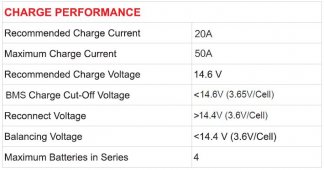Balancing current is likely only 50-100 mA resistor dump per cell. When cells are out of balance, the greater the charging current, compared to balancing current, the more likely one cell will reach its overvoltage protection voltage and shut down BMS. When BMS shuts down for a cell overvoltage, the bleed current will continue after BMS shuts off. When overvoltage cell bleeds down to its BMS reset voltage the BMS will turn back on.
When you get in this situation the BMS re-engages when overvoltage cell bleeds down to about 3.5v so it does not take much charging to put it back to overvoltage trip again. This is recoverable but takes a lot of time and aggrevation. This is why you need to keep up with balancing by taking battery charge above 14.2v at least every couple of months.
Process may repeat several times until cells finally get into balance enough to allow the charger to get to its absorb voltage setting.
Reason why I asked if you saw a step drop off in two distinct steps is with two batteries in parallel it is unlikely they both will shut down at same point in time. They may both shut down but it would be one drops first resulting is a sudden drop off in amount of current, then after some additional time the second battery shuts down finally net going to zero current.
If you hit absorb voltage you likely would not go to zero current in a few minutes. It would taper off gradually over a longer time. Immediately going to zero current is a BMS shutdown.
By setting absorb to a lower voltage, 14.0-14.2v, you give a bit more time before the highest state of charge cell reaches its overvoltage trip, allowing more time to bleed balance. Lower charge current also gives more time to balance.
When you have two batteries in parallel, when BMS on a previously tripped battery reengages, the other battery will put a fast charge into the just reset battery causing it to trip again in a short time. I would not recommend trying to rebalance these batteries in parallel. It will cause more thrashing BMS resets. You can actually get into a ping-pong situation between the two batteries' BMS's. It will eventually work out but it will lengthen the time before it does.
Balance bleed on a cell typically does not start until a cell gets above 3.4v.
If you are not in a hurry just charge at about 100 mA and after several days it will fix itself.



